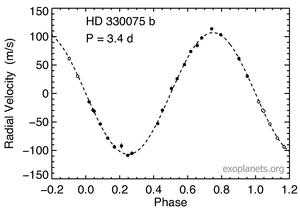HD 330075 b
| Extrasolar planet | List of extrasolar planets | |
|---|---|---|
 | ||
| Parent star | ||
| Star | HD 330075 | |
| Constellation | Norma | |
| Right ascension | (α) | 15h 49m 37.6913s |
| Declination | (δ) | –49° 57′ 48.692″ |
| Distance | 163.7 ly (50.20 pc) | |
| Spectral type | G5 | |
| Orbital elements | ||
| Semimajor axis | (a) | 0.043 AU |
| Periastron | (q) | 0.043 AU |
| Apastron | (Q) | 0.043 AU |
| Eccentricity | (e) | 0 |
| Orbital period | (P) | 3.369 ± 0.004 d (0.009224 y) |
| Argument of periastron |
(ω) | 0° |
| Time of periastron | (T0) | 2,452,878.698 ± 0.032 JD |
| Semi-amplitude | (K) | 107 ± 0.7 m/s |
| Physical characteristics | ||
| Minimum mass | (m sin i) | 0.76 MJ |
| Discovery information | ||
| Discovery date | February 10, 2004 | |
| Discoverer(s) | Pepe et al. | |
| Discovery method | Radial velocity | |
| Discovery site | La Silla Observatory, Chile | |
| Discovery status | Published | |
| Database references | ||
| Extrasolar Planets Encyclopaedia | data | |
| SIMBAD | data | |
| Exoplanet Archive | data | |
| Open Exoplanet Catalogue | data | |
HD 330075 b is an extrasolar planet approximately 164 light-years away in the constellation of Norma. This planet orbits the star HD 330075. It was discovered by the Geneva Extrasolar Planet Search team at ESO's La Silla Observatory using the HARPS spectrograph.[1]
The planet has a mass about three quarters that of Jupiter. Its orbital distance from the star is less than 1/23rd Earth's distance from the Sun, which makes HD 330075 an example of a hot Jupiter. One orbit around the star takes a little more than 3 days to complete, as compared to one year for the Earth around the Sun.[1]
References
- ↑ 1.0 1.1 Pepe, F. et al. (2004). "The HARPS search for southern extra-solar planets I. HD 330075 b: A new "hot Jupiter"". Astronomy and Astrophysics 423 (1): 385–389. arXiv:astro-ph/0405252. Bibcode:2004A&A...423..385P. doi:10.1051/0004-6361:20040389.
External links
- "HD 330075". Exoplanets. Retrieved 2008-08-16.
Coordinates: ![]() 15h 49m 37.6913s, −49° 57′ 48.692″
15h 49m 37.6913s, −49° 57′ 48.692″